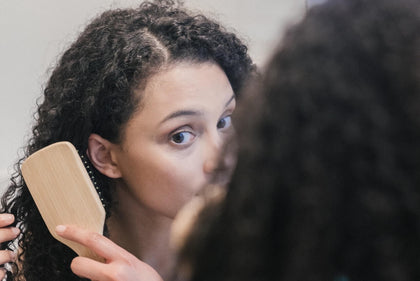If you’re starting to notice more hair fall out in your brush, on the floor, on your clothes or in the shower, please know that you are not alone. Hair loss is a very common issue that will affect a large portion of women at some point in their lives. In fact, about one-third of women will experience hair loss, according to Harvard Medical School and for post-menopausal women that number goes up even higher. To help shed light on this sensitive subject, we’ll explore the root causes of hair shedding and determine how much hair loss is considered "normal," plus, learn more about the best products to support thicker looking hair.
What Causes Hair Loss in Women?
Hair loss can be caused by several different factors, ranging from extreme stress (yes, even emotional stress brought on by the pandemic) and illness to menopause and postpartum depression. And while this experience can feel somewhat traumatic and eat away at our self esteem, the good news is that not all hope is lost, as there are a variety of solutions available.
5 Main Types of Hair Loss
There are four main types of hair loss which include:
- Alopecia Areata: This form of sudden hair loss has been shown to be triggered by autoimmune disease.
- Androgenetic Alopecia: Also called female pattern baldness, androgenic alopecia is considered hereditary and fighting against it can feel like an unending battle, but thankfully you can address this genetic form of hair loss by establishing a wellness routine early on with the right products, supplements and scalp care.
- Telogen Effluvium: This is a temporary thinning of hair and is typically related to a highly stressful event, such as physical or emotional trauma, surgery and often following pregnancy. Exercising, eating well and creating a self-care routine can help you reduce stress.
- Anagen Effluvium: A type of non-scarring alopecia, anagen effluvium is caused by a disturbance to the natural functioning of hair follicles while hair is in the anagen stage of the hair growth cycle. For example, when someone loses their hair due to chemotherapy, it is a form of anagen effluvium.
- Traction Alopecia: This is a form of balding or hair thinning usually caused by tight hairstyles.
However, there are a multitude of other reasons you might be experiencing hair loss or hair thinning, and some of them might be quite surprising.
Related: How Stress Can Lead to Hair Loss
Other Common Factors That Influence Hair Loss
Hair loss isn’t always caused by just one thing. While some people certainly experience a major stressful event that triggers hair loss or are genetically predisposed to thinning hair, other people can be affected by common, everyday things that they may not be even aware of. Here are some additional factors that may lead to hair loss:
- Nutritional Deficiencies: Your diet may be to blame — for example you may have an iron deficiency/anemia or lack protein.
- Lack of Sleep: Not getting enough sleep can cause inflammation in the body and lead to hair loss.
- Stress: This can increase cortisol levels, inhibiting hair growth.
- Thyroid Issues: Both hyperthyroidism and hypothyroidism may lead to hair loss.
- Unhealthy Scalp: Issues with your scalp can lead to hair thinning or hair follicle miniaturization, when the hair follicles constrict, making it harder for hair to grow.
- Infection: Fungal infections on the scalp can impact hair growth.
- Trauma From Hairstyling: Pulling hair too tightly with ponytails, hair extensions or braided hairstyles can result in traction alopecia. Excessive heat styling, chemical straighteners and rigorous brushing can weaken the individual strands and reduce hair volume.
- Prescription Drugs: Certain medications, including ones for cholesterol, diabetes and heart disease have been shown to affect hormone levels, triggering temporary or permanent hair loss.
Read: How to Exfoliate Your Scalp for Healthier Hair
How Much Hair Loss Is Normal?
First thing first, it’s important to note that hair shedding and hair loss are two different things. The average person sheds approximately 50 to 100 hairs a day, according to the American Academy of Dermatology. Seeing hair come out in your brush or the shower doesn't necessarily mean you're losing hair — some hair shedding is totally normal. And if you only wash your hair once a week, you may see a week's worth of excessive hair shedding accumulated in one day but that shouldn't be cause for alarm. Hair shedding is part of the natural growth cycle (hair falls out, and another one grows in), however, when less hair grows back in, that is when hair loss occurs.
The life cycle of hair has four stages, which include anagen (the growth stage), catagen (a transition stage into rest), telogen (the resting stage) and exogen (the final shedding stage). Normally, each hair follicle is independent and at a different stage of this cycle, so we’re consistently shedding and growing new hairs. "The majority of the hairs on your head are in the growth phase, and about 10% of your hair is in the resting phase," Dr. Maryanne Senna told Refinery29. "That's on purpose because if hairs grew and shed at the same time, we would all go through temporary baldness." she continues.
It's also important to remember that our hair grows approximately one centimeter per month, yet hair thinning and hair loss problems occur when this growth cycle is disturbed. This usually happens when one of the above-mentioned causes takes place.
#include-related-slider#
When to See a Dermatologist or Trichologist
Although shedding up to 100 hairs per day is normal, shedding a handful-sized amount should spark some concern. Once your mane becomes visibly thinner, the first thing you’ll want to do is find a dermatologist who specializes in hair loss, so they can help find the root of the problem. A dermatologist or trichologist can determine the exact cause of your hair loss by performing blood work to check for a nutritional deficiency, using a handheld dermatoscope to check for skin lesions on the scalp, performing a strand test, a pluck test (pulling hair out by the roots) or a simple biopsy. Knowing the exact cause of your hair loss can help you better understand how to approach it.
Shop: GRO Dry Shampoo
How to Prevent Hair Loss
A great way to prevent hair loss is to keep yourself as healthy as possible. This includes establishing a good workout routine, eating a nutrient-rich diet, getting at least seven to eight hours of sleep every night and managing stress levels. Engaging in relaxing activities like yoga or meditation may also be beneficial, but if those aren’t quite right for you, try to find something else that does like a new hobby or spending quality time with loved ones. In order to achieve hair wellness, you really need to take care of yourself first.
What Are the Best Solutions for Thinning Hair?
For those who are experiencing treatable, reversible hair loss, one of the best options is keeping the hair in the growth phase for as long as possible for healthier, longer strands of hair. But how can you support your hair’s natural growth cycle? Well, one way is to consider taking a supplement. Vitamins or topical supplements can help nourish hair and keep hair growing for as long as possible. Use a hair serum that helps extend the anagen phase for thicker hair. You can also add a daily hair vitamin to supplement your diet with vitamins and minerals that can help support healthy hair.
As your body needs constant nourishment, so does your hair — so the key to using any growth-boosting formula is to maintain a consistent routine to ensure optimal results.
#include-related-slider#
More From VEGAMOUR
- How to Get Thicker Hair
- Do Eyelashes Grow Back?
- Can IUD Cause Hair Loss?
- What Your Hair Can Tell You About Your Overall Health



















